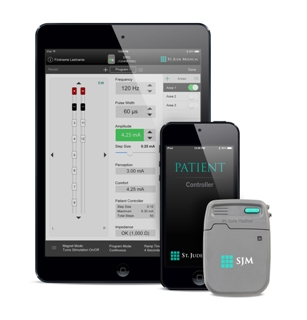Jun 8 2015
St. Jude Medical, Inc., a global medical device company, today announced CE Mark approval and the European launch of the St. Jude Medical Invisible Trial System, an app-based and wireless neuromodulation programming system leveraging Apple™ iPod touch™ and iPad mini™ technology.
 With the new Invisible Trial System, St. Jude Medical aims to allow patients to focus more on potential pain relief and therapeutic impact during their spinal cord stimulation trial period, and less on the trial system itself. (Photo: St. Jude Medical)
With the new Invisible Trial System, St. Jude Medical aims to allow patients to focus more on potential pain relief and therapeutic impact during their spinal cord stimulation trial period, and less on the trial system itself. (Photo: St. Jude Medical)
Like other Apple products, the new St. Jude Medical system relies on Bluetooth communication, providing a secure, safe, and wireless experience when patients trial spinal cord stimulation for the treatment of chronic pain prior to permanent implantation.
“I expect that the St. Jude Medical Invisible Trial System will significantly improve the trial experience for my patients,” said Dr. Stefan Schu, specialist for neurosurgery and senior physician for neuromodulation at the Sana Clinic in Duisburg, Germany. “The new system will be discreet, familiar and require no cables that can be uncomfortable or potentially cause the lead to dislodge. Perhaps the most important feature is the therapy itself, which will enable a unique Burst stimulation mode that will expand the range of stimulation modes available in the trial phase and thereby potentially improve the trial success rate for my patients suffering from chronic pain.”
One of the key system features of the Invisible Trial System is the use of an external pulse generator (EPG) as the system’s power source. The EPG is small, and uses Bluetooth communication to communicate between the patient’s iPod touch controller and the stimulation system. As a result, the system can now be worn under a patient’s clothing, often rendering the entire system “invisible” and providing a more comfortable trial experience. The goal is for patients to focus more on potential pain relief and therapeutic impact during their trial and less on the trial system itself.
The iPod touch controller offers patients a simple, familiar platform to adjust their therapy. An iPad mini tablet is used by the patient’s physician to set the programming parameters. The programmer also displays trial usage data from the EPG and allows the physician to print or email the data in PDF format. Bluetooth technology safely and securely communicates wirelessly between the EPG and patient and physician devices, eliminating the programming trial cable and thus increasing the patient’s comfort.
The new trial system has the capability to deliver both traditional and Burst stimulation modes. Burst stimulation has been demonstrated to minimize paresthesia in most patients. Paresthesia is a sensation which can often fluctuate with posture and body position changes and negatively impact the trial experience. Being able to utilize the Burst stimulation mode in a trial setting expands the range of available stimulation modes for chronic pain sufferers in the trial phase and in addition offers the potential to trial Burst stimulation for patients who did not respond to traditional tonic stimulation previously.
“We’ve developed our new patient-centric Invisible Trial System as a response to physician and patient feedback,” said Eric S. Fain, M.D., group president of St. Jude Medical. “The system was designed to improve the comfort and usability of our system for patients evaluating spinal cord stimulation therapy to alleviate their chronic pain without focusing on potential barriers such as programming trial cables and systems with complex trial controls.”
Chronic pain affects one in five adults across Europe and more than 1.5 billion people worldwide. Spinal cord stimulation (also known as neurostimulation or SCS) therapy is a proven therapy for managing chronic pain. SCS uses a small implanted medical device and thin wires or leads with electrodes, placed in the epidural space near the spine, to deliver low levels of electrical energy to nerve fibers. These electrical pulses mask or interrupt pain signals as they travel to the brain, reducing pain sensation. Before receiving the permanent implanted device, patient’s candidates can evaluate the therapy by having a minimally invasive procedure used to place the lead, which is connected to an external power source.